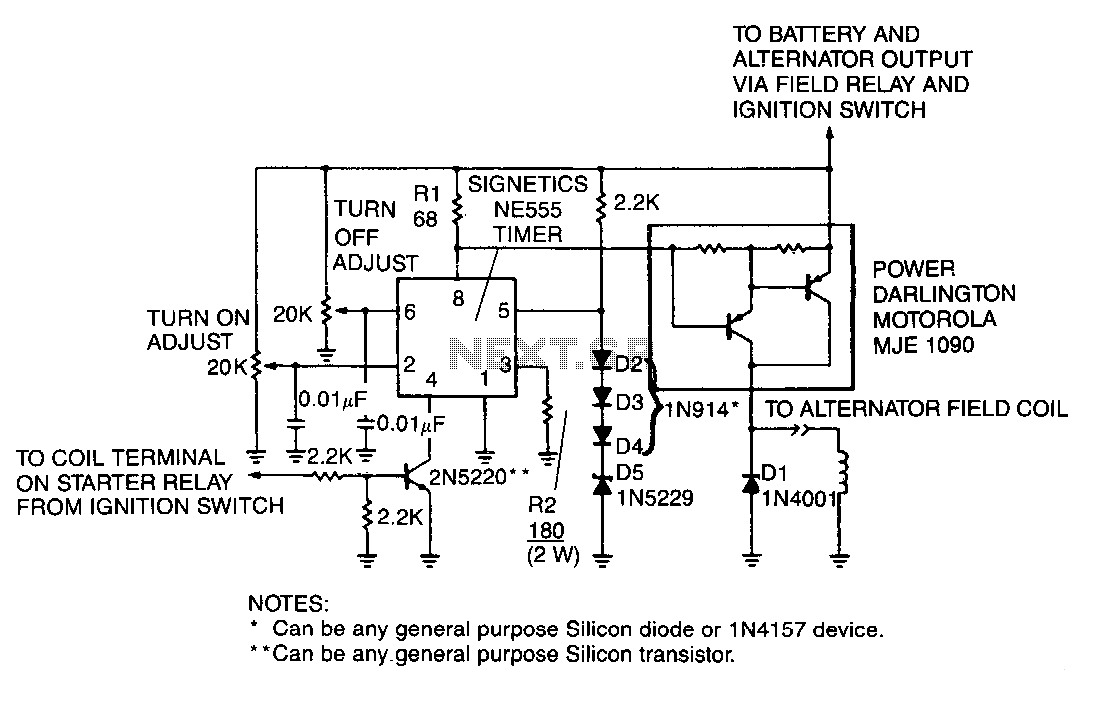
Automobile-voltage-regulator

A monolithic 555-type timer serves as the core component of this straightforward automobile voltage regulator. When the timer is inactive, resulting in a low output at pin 3, the power Darlington transistor pair remains off. If the battery voltage drops below 14.4 V, the timer activates, causing the Darlington pair to conduct. A general-purpose silicon diode or a 1N4157 device can be utilized. Additionally, any general-purpose silicon transistor may be employed.
The described automobile voltage regulator utilizes a monolithic 555 timer, which is a versatile and widely used integrated circuit capable of functioning in various configurations. In this application, it operates in a comparator mode, monitoring the battery voltage to ensure it remains within acceptable limits.
The 555 timer's output at pin 3 is critical for controlling the state of the power Darlington transistor pair. When the battery voltage is adequate (above 14.4 V), the timer output is low, keeping the Darlington transistors off and preventing any excess current draw from the battery. This condition helps to maintain the battery's charge and prolong its lifespan.
When the battery voltage falls below the predetermined threshold of 14.4 V, the 555 timer activates, switching its output high. This transition turns on the Darlington transistor pair, allowing current to flow and effectively regulating the voltage supplied to the automobile's electrical system. The use of a Darlington pair enhances the current gain, ensuring that even a small input signal from the timer can control a much larger load.
The choice of components, such as the general-purpose silicon diode or the 1N4157, is important for ensuring reliable operation. The diode serves as a rectifier, allowing current to flow in one direction while blocking reverse current, which could otherwise damage the circuit. The general-purpose silicon transistor can be utilized in various configurations depending on the specific requirements of the application, providing flexibility in design.
Overall, this simple yet effective voltage regulator circuit leverages the capabilities of the 555 timer to monitor and maintain battery voltage, ensuring the reliable operation of automotive electrical systems.A monolithic 555-type timer is the heart of this simple automobile voltage regulator. When the timer is off so that its output at pin 3 is low, the power Darlington transistor pair is off. If battery voltage becomes too low, less than 14.4 V in this case, the timer turns on and the Darlington pair conducts.
Can be any general purpose Silicon diode or 1 N4157 device. Can be any_general purpose Silicon transistor.
The described automobile voltage regulator utilizes a monolithic 555 timer, which is a versatile and widely used integrated circuit capable of functioning in various configurations. In this application, it operates in a comparator mode, monitoring the battery voltage to ensure it remains within acceptable limits.
The 555 timer's output at pin 3 is critical for controlling the state of the power Darlington transistor pair. When the battery voltage is adequate (above 14.4 V), the timer output is low, keeping the Darlington transistors off and preventing any excess current draw from the battery. This condition helps to maintain the battery's charge and prolong its lifespan.
When the battery voltage falls below the predetermined threshold of 14.4 V, the 555 timer activates, switching its output high. This transition turns on the Darlington transistor pair, allowing current to flow and effectively regulating the voltage supplied to the automobile's electrical system. The use of a Darlington pair enhances the current gain, ensuring that even a small input signal from the timer can control a much larger load.
The choice of components, such as the general-purpose silicon diode or the 1N4157, is important for ensuring reliable operation. The diode serves as a rectifier, allowing current to flow in one direction while blocking reverse current, which could otherwise damage the circuit. The general-purpose silicon transistor can be utilized in various configurations depending on the specific requirements of the application, providing flexibility in design.
Overall, this simple yet effective voltage regulator circuit leverages the capabilities of the 555 timer to monitor and maintain battery voltage, ensuring the reliable operation of automotive electrical systems.A monolithic 555-type timer is the heart of this simple automobile voltage regulator. When the timer is off so that its output at pin 3 is low, the power Darlington transistor pair is off. If battery voltage becomes too low, less than 14.4 V in this case, the timer turns on and the Darlington pair conducts.
Can be any general purpose Silicon diode or 1 N4157 device. Can be any_general purpose Silicon transistor.